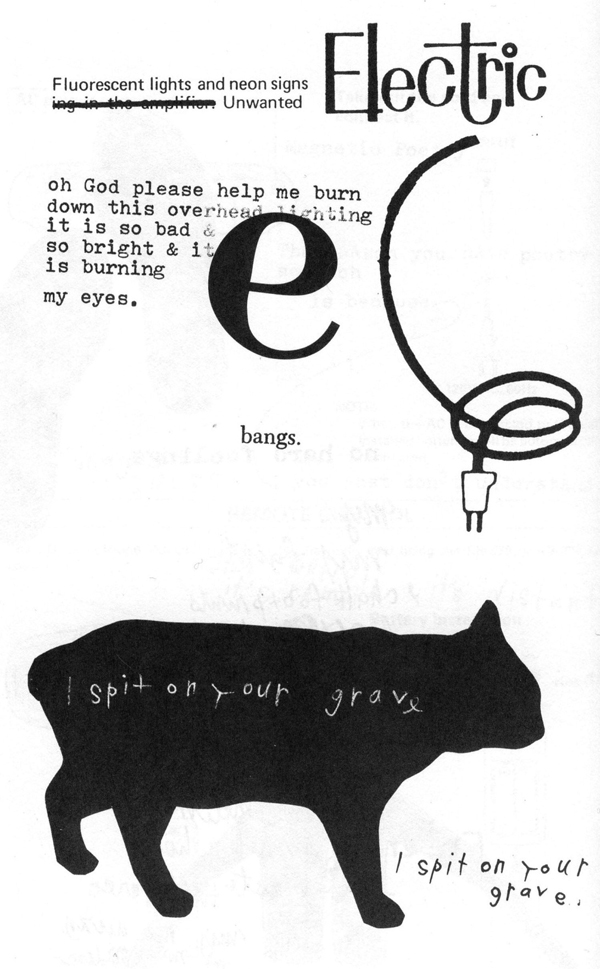【vital eroticism definition】
Vispo
On Language
The Paris Review’s interviews have long featured single manuscript pages from among the subjects’ writings. They are meant to show the author at work, his or her method of self-editing, of revision—an illustrative supplement to the process described at length in the conversations. To me, though, they always exist first as instances of visual artistry. The particularities of each writer’s markings are immediately perceptible: the way Margaret Atwood’s handwritten lines appear impatient and vital in contrast with the prim logos of the SAS Hotel stationery on which she penned a poem; the way Yves Bonnefoy’s long, spidery insertion lines give physicality to the pallid rows of words; the way David McCullough’s xed-out typewritten phrases become so many tiny, busy intersections. In the same way, I’ve always found the looping inscriptions of Cy Twombly’s “blackboard” paintings, in particular Cold Stream, to be a kind of magic—the secret scribblings, writ large, of a mind at work. (It’s no coincidence that Twombly worked as a cryptographer in the army.)
I’m struck by the frequency, in Paris Reviewinterviews, with which authors describe writing as being a visual activity. John Edgar Wideman imagines his drafts as “palimpsests.” Don DeLillo finds that “the words typed on the white page have a sculptural quality … They match up not just through meaning but through sound and look.” Nicholson Baker admits, “I can fiddle around with something on a screen for days and think I’m getting somewhere, and it won’t be right. Then I’ll print it out and take it to bed, and instantly it’s obvious what’s bad about it, and I’ll cross out, cross out, cross out.” Words become objects, things to be looked at. I’m reminded of Apollinaire’s calligrams, Jackson Mac Low’s grid poems, and Robert Smithson’s Heap of Language(1966), which views words and phrases as “matter and not ideas.”
In poetry, such notions have long held sway: micrography, or text that forms an image, dates from ninth-century biblical codices; instances of concrete poetry exist in seventeenth-century religious poetry, and also in the early-twentieth-century works of the anarchist Futurists; asemic writing is a wordless, ideogramic form that Henri Michaux described as “interior gestures” and Roland Barthes called his “contre-écriture” (see, again, Twombly and also Jackson Pollock). Poetry that can’t simply be read or heard must be seen, experienced, enacted; how it is interpreted is the reader’s prerogative. In this way, both writing and reading are performance. In the new Winter issue, Susan Howe says, “I often think of the space of a page as a stage, with words, letters, syllable characters moving across.” In the 1960s, composer Cornelius Cardew wrote a number of indeterminate scores—stunning visual experiments—that cannot be read in any traditional way and that, like these examples of poetry, charge the performer with interpreting abstract forms and shapes that allow for an unlimited set of permutations.
Lest we think visual poetry reached its apogee as a phenomenon in the mid-twentieth century, we have The Last Vispo Anthology: Visual Poetry 1998–2008, a sampling of the current, international state of the art. For coeditors Nico Vassilakis and Crag Hill and the anthology’s wide-ranging practitioners, Vispo (a portmanteau of visual poetry) is poetry that begins on the molecular level: “It’s alphabet in every possible and available position you can imagine … The alphabet [as] a periodic table of speech elements.” And between these scripted platelets is room to shift and stir. If poetry ought to be performative, as James Fenton recommends, then it makes sense that in visual form poetry would elicit a kind of motion, an unfolding over the space of a page, and that even its sound would be voiced as a series of discoveries. Movement disrupts the continuity of a sentence, a phrase, a word. And language, unsettled, is unbound.
Pause Play Play Prev | Next
Search
Categories
Latest Posts
How to make a hook in a TikTok video
2025-06-27 03:53Nowhere to Go But Everywhere by Sadie Stein
2025-06-27 03:51Frederick Seidel’s “Widening Income Inequality” by Hailey Gates
2025-06-27 02:10The Immortality Chronicles, Part 4 by Adam Leith Gollner
2025-06-27 01:37Meta says some AGI systems are too risky to release
2025-06-27 01:29Popular Posts
'Quordle' today: See each 'Quordle' answer and hints for July 11
2025-06-27 02:59On Keeping a Notebook, Part 1 by Sarah Gerard
2025-06-27 02:45The 12 Best Games on the iPhone
2025-06-27 02:38Featured Posts
Wordle today: The answer and hints for January 23, 2025
2025-06-27 03:17Ah, Underpants! by Sadie Stein
2025-06-27 02:46Childish Things
2025-06-27 02:37Damned Spot by Sadie Stein
2025-06-27 01:53PlayerUnknown's Battlegrounds Mini
2025-06-27 01:47Popular Articles
They met on Tumblr, and their relationship outlasted their accounts
2025-06-27 04:07Good Things by Sadie Stein
2025-06-27 03:51My Nothing to Hide by Amy Grace Loyd
2025-06-27 03:30Don’t Snip My Brakes in Long Beach by Dave Tompkins
2025-06-27 02:02AI models don’t understand Gen Alpha slang
2025-06-27 01:55Newsletter
Subscribe to our newsletter for the latest updates.
Comments (959)
Dream Information Network
Amazon CEO tries to sell kids on working on the moon
2025-06-27 02:50Pursuit Information Network
In Which Jane Austen Tells Your Fortune, and Other News by Sadie Stein
2025-06-27 02:23Future Information Network
This Is Just to Say by Sadie Stein
2025-06-27 02:19Time Information Network
Emmy nominations 2023: How and when to watch
2025-06-27 02:17Prosperous Times Information Network
Biggest Tech Fads of the Last Decade
2025-06-27 02:15